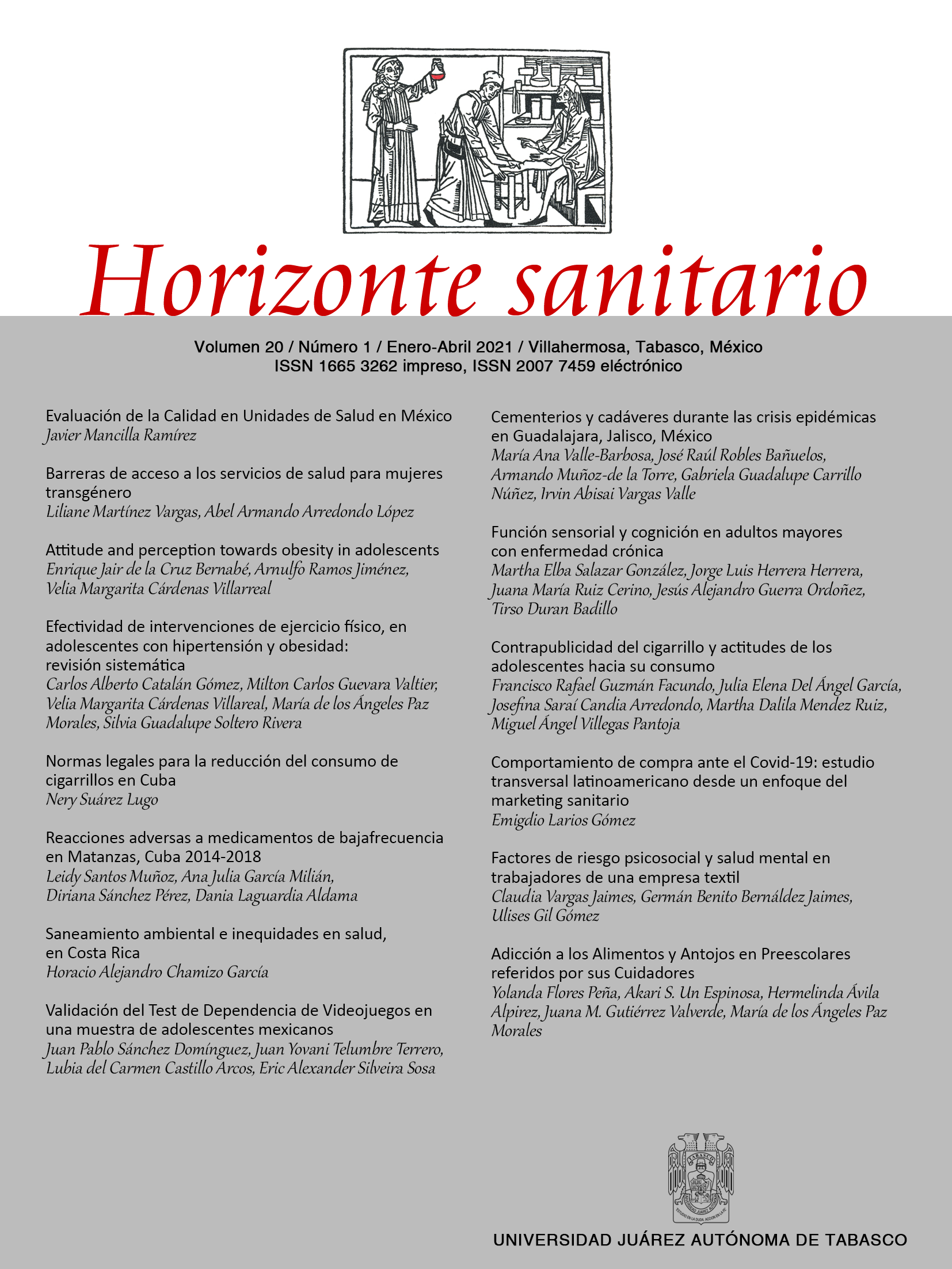Saneamiento ambiental e inequidades en salud en Costa Rica
DOI:
https://doi.org/10.19136/hs.a20n1.3718Abstract
El saneamiento ambiental es un determinante social de la salud que forma parte de los Objetivos del Desarrollo Sostenible. objetivo: analizar inequidades en salud asociadas a condiciones de saneamiento ambiental y acceso al seguro de salud. métodos: Se diseñó un estudio transversal mediante el análisis de la encuesta nacional de hogares de Costa Rica 2018 representativa estadísticamente de la población nacional. Se obtuvo la frecuencia de privación material atribuible a diez indicadores de saneamiento ambiental y acceso al seguro de salud. Se realizaron pruebas estadísticas inferenciales y análisis estratificado según nivel educativo y condición socioeconómica. resultados: la privación material medida a través de indicadores de saneamiento ambiental y acceso al seguro de salud se presenta en proporciones relativamente pequeñas respecto al total de la población, aunque aumenta como tendencia consistente y significativa estadísticamente, en la medida que disminuye el nivel educativo y aumenta la pobreza. La presencia de servicio sanitario inadecuado es 35.14 (27,05-41,00) veces más frecuente en hogares cuyo jefe no supera el nivel educativo de primaria y 7,78 (7,03-8,20) veces más frecuente en hogares con pobreza extrema. Así mismo, la frecuencia de hogares que cocinan con leña o carbón llega ser 29,1 (23,04-35,8) veces más frecuente en hogares cuyo jefe no supera el nivel educativo de primaria. conclusiones: existen inequidades en la privación material atribuible al saneamiento ambiental y el acceso al seguro de salud en Costa Rica, lo que se asocia al nivel de educación y el nivel de ingresos económicos de la población.Downloads
References
Hendriksem, K., & Hoffman, B. Greenlandic water and sanitation-a context oriented analysis. Environmental Sci Pollunt Res.2018; (25): 33014-33024. Disponible en: https://link.springer.com/article/10.1007/s11356-017-9862-z
Coll, C., Mias, M., & Garcia Altés, A. Un índice de privación para reformar el modelo de financiación para reformar el modelo de atención primaria en Cataluña. Gaceta Sanitaria. 2020; 34(1): 44-50. Disponible en: Doi:101016/gaceta.2018.07.015
Pan American Health Organization. Workshop toward the elimination of the use of solid fuel and kerosene in urban homes in the americas. Mexico: PAHO. 2018. Disponible en: https://www.paho.org/hq/index.php?option=com_docman&view=download&slug.
Siddhartan, T., Grigsby, M. R., Goodman, D., Chowdhury, M., Rubinstein, A., Irazola. Et al. Association between household air pollution exposure and chronic osbstructiva pulmonary disease outcomes in 13 low an middle-income country settings. American Journal Respi Crit Care. 2018: 611-620. Disponible en: www.atsjournals.org. DOI: 10.1164/rccm.201709-1861OC
Maharana, S. P., Paul, B., Garg, S., Dasgupta, A., & Bandyopadhyay, L. Exposure to indoor air pollution and its perceived impact on health of women and their children: a household survey in a slum of Kolkata, India. Indian Journal of Public Health. 2018. Disponible en: DOI:10.4103/ijph.IJPH_259_18
Denmana, A. R., Crocketta, R. G., Groves-kirkbya, C. J., Phillipsa, P. S., & Gillmoreb, G. K. Exploring the relationsship between social deprivation and domestic radon levels in the East Midlands, UK. Journal of Environmental Radioactivity. 2019: 84-98. Disponible en: https://doi.org/10.1016/j.jenvrad.2019.01.010
Alemu, F., Kumie, A., Medhin, G., Gebrer, T., & Godfrey, P. A socio-ecological analysis of barriers to the adoption, sustainablity and consistent use of sanitation facilities in rural Ethiopia. BMC Public Health. 2017; 17(706). Disponible en: DOI 10.1186/s12889-017-4717-6
Novotny, J., Hasman, j., & Lepic, M. Contextual factors and motivations affecting rural community sanitation in. Internatonal Journal of Hygiene and Environmental Health.2018: 121-133. Disponible en: https://doi.org/10.1016/j.ijheh.2017.10.018
Owada, K., Nielsen, M., Colleen, L. L., Yakob, L., Clements, A. C., Leonardo, L. et al. Determinants of Spatial Heterogeneity of Functional Illiteracy among School-Aged Children in the. Int. J. Environ. Res. Public Health.2019; 16(137). Disponible en: doi:10.3390/ijerph16010137
Matos, A. M., Coelho, A. C., Araujo, L. P., Alves, M. J., Baquero, O. S., Duthie, M. S. et al. Assessing epidemiology of leprosy and socio-economic distribution of cases. Epidemiology and Infection. 2018: 1750-1755. Disponible en: https://doi.org/10.1017/S0950268818001814
Brown, C., & Heller, L. Development cooperation in water and sanitation: is it based on the human rights framework. Ciencia y Saude Coletiva. 2017: 2247-2256. Disponible en: DOI: 10.1590/1413-81232017227.04872017
Instituto Costarricense de Estadísticas y Censos. Encuesta Nacional de Hogares 2018. 2018. Disponible en:http://sistemas.inec.cr:8080/bininec/RpWebEngine.exe/Portal?BASE=ENAHO2018&lag=esp
Qing, L., Zhang, M., Yao, W., Fu, Y., Wei, H., Tao, Y. et al. A spatio-temporal paterrn and socio-economic factor analysis of improved sanitation in China, 2006-2015. Int. J. Environ. Res. Public Healht. 2018. Disponible en: doi:10.3390/ijerph15112510
Chao, W., Pan, J., Yaya, S., Bilash Yadav, R., & Yao, D. Inequalities in Accessing Improved Water and Sanitation. Journal Environmental Res. Public Health. 2019. Disponible en: doi:10.3390/ijerph16071269
ArKo-Mensah, J., Darko, J., Noye Nortey, E. N., May, J., Meyer, C. G., & Fobil, J. N. Socioeconomic Status and Temporal Urban Environmental Change in Accra: a Comparative Analysis of Area-based Socioeconomic and Urban Environmental Quality Conditions Between Two Time Points. Environmental Management. 2019: 574-582. Disponible en: https://doi.org/10.1007/s00267-019-01150-1
Ezbakhe, F., Perez-Foguet, A., & Giné Garriga, R. Leaving no one behind: Evaluating access to water, sanitation and hygiene for vulnerable and marginalized groups. Science of the Total Environment. 2019; (683): 537-546. Disponible en: https://doi.org/10.1016/j.scitotenv.2019.05.207
Wen-Jun, H., Ying-Si, L., Karmachararya, B. M., Bo-Feng, D., Yuan Tao, H., & Dong, X. R. Geographical heterogeneity and inequality of access to improved drinking water supply and sanitation in Nepal. International Journal for Equity in Health.2018; 17(40). Disponible: https://doi.org/10.1186/s12939-018-0754-8
Knee, J., Sumner, T., Adriano, Z., Berendes, D., de Brujn, E., Scmidt, P. et al. Risk factors for childhood enteric infection in urban Maputo, Mozambique: A cross-sectional study. PLoS Negl Trop Dis. 2018. Disponible en: https://doi.org/10.1371/journal.pntd.0006956
Paul A, E., & Bubak, V. Closing the rural-urban gap in child malnutrition: Evidence from Paraguay, 1997–2012. Economics and Human Biology. 2019; (32). Disponible en: https://doi.org/10.1016/j.ehb.2018.11.001
Amini Mshida, H., Kasim, N., Epafras Kimanya, M., & Mpolya, E. Influence of Water, Sanitation, and Hygiene Practices on Common Infections among Under-Five Children in Longido and Monduli Districts of Arusha, Tanzania. Journal of Environmental and Public Health. 2017. Disponible en: https://doi.org/10.1155/2017/9235168
Holgegren, I., Rauch, S., Cossio, C., Landaeta, G., & McConville, J. Importance of triggers and veto-barriers for the implementation of sanitation in informal peri-urban settlements ± The case of Cochabamba, Bolivia. PLoS One. 2018: 13(4). Disponible en: https://doi.org/10.1371/journal.pone.0193613
Cronin, A. A., Odagiri, M., Arsyad, B., Nuryetty, M. T., Amannullah, G., Santoso, H., . . . Nasution, N. A. Piloting water quality testing coupled with a national socioeconomicsurvey in Yogyakarta province, Indonesia, towards tracking ofSustainable Development Goal 6. International Journal of Hygiene and Environmental Health; 2017; 220, 1141-1151. Disponible en: http://dx.doi.org/10.1016/j.ijheh.2017.07.001
Caron, Y., Hong, R., Gauthier, L., Laillou, A., Wieringa, F. T., Berger, J., & Poirot, E. Stunting, Beyond Acute Diarrhoea: Giardia Duodenalis, in Cambodia. Nutrients. 2018;10(1420). Disponible en: doi:10.3390/nu10101420
Sahiledengle, B. Prevalence and associated factors of safe and improved infant and young children stool disposal in Ethiopia: evidence from demographic and health survey. BMC Public Health. 2019; 19(970). Disponible en: https://doi.org/10.1186/s12889-019-7325-9
Watson, C. H., Baker, S., Lau, C. L., Rawalai, K., Taufa, M., & Cariakula, J. A cross-sectional seroepidemiological survey of typhoid fever in Fiji. PLoS Negl Trop Dis. 2017; 11(7). Disponible en: https://doi.org/10.1371/journal.pntd.0005786 July 20, 2017
Exum, N. G., Lee, G. O., Paredes Olortegue, M., Peñarato Yori, P., Siguas Salas, M., & Rengifo Trigoso, D. A Longitudinal Study of Household Water, Sanitation, and Hygiene Characteristics and Environmental Enteropathy Markers in Children Less than 24 Months in Iquitos, Peru. Am. J. Trop. Med Hyg. 2018; 98(4), 995-1004. Disponible en: doi:10.4269/ajtmh.17-0464
Capolongo, S., Rebecchi, A., Dettori, M., Appolloni, L., & Azara, A. Healthy Design and Urban Planning Strategies, Actions, and Policy to Achieve Salutogenic Cities. International Journal of Environ. Res Public Health. 2018; 15(2698). Disponible en: doi:10.3390/ijerph15122698
Musoke, D., Ndejjo, R., Halage, A. A., Kasasa, S., Ssempebwa, J. C., & Carpenter, D. O. Drinking Water Supply, Sanitation, and Hygiene Promotion Interventions in Two Slum Communities in Central Uganda. Hindawi Journal of Environmental and Public Health. 2018; Disponible en: https://doi.org/10.1155/2018/3710120
Lipfert, F. W., & Wyzga, R. E. Environmental predictors of survival in a cohort of U.S. military veterans: a multi-level spatio-temporal analysis stratified by race. Environmetal Research. 2020; Disponible en: https://doi.org/10.1016/j.envres.2019.108842
Shamsaei, B., Meller, J., Indugula, R., & Reponen, I. Variability of indoor fungal microbiome of green and norn green low income homes in Cincinnati, Ohio. Science of the Total Environment. 2018; 212-218. Disponible en:http://dx.doi.org/10.1016/j.scitotenv.2017.07.274
Tazinya, A. A., Halle-Ekane, G. E., Mbuagbaw, L. T., Abanda, M., Atqashili, J., & Obama, M. T. Risk factors for acute respiratory infections. BMC Pulmonary Medicine. 2018; 18(7). Disponible en: DOI 10.1186/s12890-018-0579-7
Burgos, S., Sigala, F., Argueta, L., & Iglesias, V. Salud ambiental infantil en el contexto de la reubicación de familias de campamentos a viviendas sociales. Revista Chilena de pediatria. 2015; 152-160. Disponible en:http://dx.doi.org/10.1016/j.rchipe.2015.06.001
Brown, N., Rizvi, A., & Kerai, S. Recurrence of WHO-definened fast breathing neumonia among infants, its ocurrence and predictors in Pakistan a nasted case-control analysis. BMJ Open. 2020. Disponible en: doi:10.1136/bmjopen-2019-035277
Elf, J. L., Kinikar, A., Sandhya, K., Maven, V., Suryavanshi, N., & Gupte, N. Sources of household air pollution and their asscociation with fine particulate matter in low-income urban home in India. Jorunal of Exposure Science and Environmental Epidemiology. 2018; 28. 400-410. Disponible en: https://doi.org/10.1038/s41370-018-0024-2
Bryant-Stephens, T. Asthma disparities in urban environments. Clinical Rewiews in Allergy and Immunology. 2009. Disponible en: doi:10.1016/j.jaci.2009.04.030
Soto-Moreno, J. A., & Ballester-Diez, F. Contaminación del aire en interiores en hogares en situaión de pobreza extrema en Colombia. Revista de Salud Pública. 2013; 15 (1): 80-89
Ghimire, S., Raj Mishra, S., Sharma, A., Siweya, A., Shrestha, N., & Adhikari, B. Geographic and socioeconomic variation in markers of indooor air pollution in Nepal. BMC Public Health. 2019. 19 (195). Disponible en: https://doi.org/10.1186/s12889-019-6512-z
Pedrazzoli, D., Boccia, D., Dodd, J., L onnroth, K., Dowdy, D. W., Siroka, A., . . . Houben, J. Modelling the socioal and structural determinants of tuberculosis: oportunities and challenges. The International Journal of Tuberculosis and Lung Disease. 2017; 957-964. Disponible en: http://dx.doi.org/10.5588/ijtld.16.0906
Chamizo Garcia, H. A. Inequidades geográficas y tuberculosis en Costa Rica:2008-2012. Población y Salud en Mesoamérica. 2016; 13 (2). Disponible en: DOI: 10.15517/psm.v13i2.21455
McCuskee, S., Garchitorena, A., Miller, A. C., Hall, L., Ali Ouenzar, M., Rabeza, V. R., Bonds, M. H. Child malnutrition in Ifanadiana district, Madagascar: associated factors and timing of growth faltering ahead. Global Health Action. 2018; 11(1). Disponible en: DOI:10.1080/16549716.2018.1452357
Pak, G. D., Haekyung, A., Seo, H. W., Osei, I., & Amuasi, J. The HPAfrica protocol: Assessment of health behaviour and population based socioeconomic, hygiene behavioural factors- a standardised repeated cross-sectional study inmultiple cohorts in sub-Saharan Africa. BMJ Open. 2018. Disponible en: doi:10.1136/bmjopen-2017-021438
Makoge, V., Vaandrager, L., Maat, H., & Koelen, M. Poverty and health among CDC plantation labourers in Cameroon: Perceptions, challenges and coping strategies. PLoS Negl Trop. 2017; 11(11) Disponible en: https://doi.org/10.1371/journal.pntd.0006100
Yusti, D., Arboleda, M., & Agudelo-Flores, P. Factores de riesgo sociales y ambientales relacionados con casos de leptospirosis de manejo ambulatorio y hospitalario, Turbo, Colombia. Biomedica. 2013; 33 (1) Disponible en: http://dx.doi.org/10.7705/biomedica.v33i0.1457





























